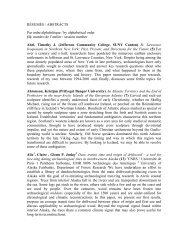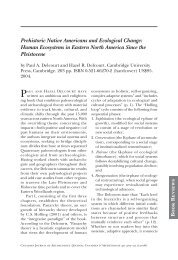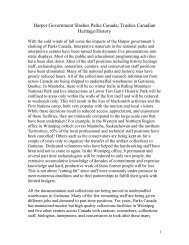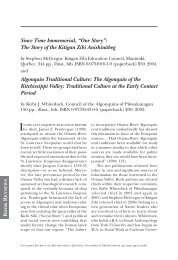16 - 20 MAI MAY 16 - 20 - Canadian Archaeological Association
16 - 20 MAI MAY 16 - 20 - Canadian Archaeological Association
16 - 20 MAI MAY 16 - 20 - Canadian Archaeological Association
You also want an ePaper? Increase the reach of your titles
YUMPU automatically turns print PDFs into web optimized ePapers that Google loves.
social and pedagogical implications of this project are discussed and<br />
future work is proposed.<br />
Arnett, Chris (University of British Columbia) • Picture This: Salishan<br />
Rock Painting as Resistance [22]<br />
Rock art studies in Western North America rely on 19 th century ethnographic<br />
models of interpretation which attribute the production of<br />
rock art to a range of activities in a variety of locations. The ethnographic<br />
and archaeological record suggests variability over time but<br />
in the Salishan territories there is a consistent Late Period association<br />
between large rock painting displays, overland trail systems and<br />
natural travel corridors such as lakes and inlets. The paintings along<br />
these travel corridors are on distinctive landforms associated with<br />
mythological events. From the cultural perspective, tumulh, the red<br />
ochre paint used in the paintings, has protective qualities. The iconography,<br />
rarely seen in public as it was the product of shwoonAhm<br />
guardian spirits and dreams, served a similar function. Thus Salishan<br />
rock paintings fulfilled a dual purpose: the rock (the mythological<br />
being and its story/teachings) was marked and protected and the<br />
paintings, possessed of material agency, served as a prophylactic, deterrent<br />
art placed in a visible location to mitigate social and cultural<br />
disruption connected to European influences.<br />
Arsenault, Daniel (CÉLAT-UQAM, Université du Québec à Montréal)<br />
• Rock art as non art: towards the interpretation of some peculiar<br />
“rock art” sites in the Far-Eastern <strong>Canadian</strong> Shield! [22]<br />
The North Shore of the St. Lawrence River, Québec, has yielded a few<br />
rock painting sites, but just two of them can be identified as real “rock<br />
art sites” thanks to their graphic contents. Three other sites are rock<br />
outcrops with some smudges of red ochre. What can be said about<br />
such sites without visual symbols? Indeed some clues are found in<br />
Innu traditions as well as in XVIII th century’s old maps, but the results<br />
of the <strong>20</strong>11 summer fieldwork offer additional answers and some<br />
insights for the better interpretation of what appears to be rock art<br />
sites without graphic.<br />
Aslan, Jasmine • Métis Captains’ Coats: Articulating Similarity and<br />
Difference [25]<br />
Although the establishment of the fur trade in North America is often<br />
described in negative or destructive terms, cultural contact also engendered<br />
processes of creation and invention. From the <strong>16</strong> th century<br />
on, indigenous groups assimilated foreign goods and manufacturing<br />
techniques, producing any number of ‘hybrid’ artefacts. In this paper,<br />
I discuss the emergence and evolution of one such class of objects:<br />
painted hide captains’ coats. Made according to traditional processes,<br />
they nonetheless reflect striking European influences in their design.<br />
My discussion of these artifacts hinges on research I conducted into<br />
the ethnohistories of two such garments from the British and Pitt<br />
Rivers museums’ collections. In the first part of my paper, I consider<br />
models and approaches in the study of hybrid artifacts, and the ways<br />
in which these affected my ethno-archaeological analyses of these<br />
specimens. In the second, I present my findings; the outcome of my<br />
research into their ethnohistories.<br />
Astudillo, Fernando (University of Calgary), Daniela Balanzátegui,<br />
and Barbara Winter (Simon Fraser University) • Collectors,<br />
Forgers, and Looters: The History behind Andean Ancient Art [1]<br />
The publication of “Incidents of Travel and Expedition in the Land<br />
of the Incas” (Squier 1887), showing drawings of Inca art, created a<br />
demand in Europe and North America for “Andean antiquities”. As result,<br />
collectors and museums included in their wish list the Andean<br />
art as an essential piece. The demand created a network of looters<br />
and artisans that made replicas often sold as authentic. These replicas<br />
are now part of the modern museum collections worldwide. The<br />
Museum of Archaeology and Ethnology of Simon Fraser University<br />
(Burnaby, B.C), have objects associated with Andean pre-Columbian<br />
societies such as Inca, Chimu, Moche, Pasto, Quimbaya, Tumaco-La<br />
Tolita, Manteño, and Sican. In the format of a museum temporary exhibit<br />
we presented to the public the probable reasons why the ceramics<br />
form part of the collection. Objects of Andean cultures have special<br />
significance for collectors and museums; however, it does not mean<br />
that they are authentic.<br />
Bain 1 , Allison, William Moss 2 , Réginald Auger 1 and Marcel Moussette<br />
1 ( 1 Université Laval, 2 Ville de Québec) • Celebrating 30 years<br />
of Teaching and Promoting Historical Archaeology in Quebec City [28]<br />
In partnership with the Ville de Québec and Québec’s Ministry of Culture,<br />
Communications and Women’s Condition, Université Laval has<br />
offered a field school in Historical Archaeology since 1982. In <strong>20</strong>12<br />
we will celebrate thirty years of training young archaeologists. Over<br />
400 undergraduate and graduate schools have been trained under<br />
three different field directors. The school has worked at three major<br />
sites in the City: the Intendant’s Palais; Domaine de Maizerets and<br />
the îlot Hunt site, now known as the award-winning Auberge Saint-<br />
Antoine. This presentation will discuss each of these projects and will<br />
highlight the importance of consistent training and collecting methods,<br />
and the key role that long term partnership agreements have<br />
played for research and the development of theoretical agendas as<br />
well as for the promotion of archaeology within this UNESCO World<br />
Heritage City.<br />
Banks 1 , William E., Francesco d’Errico, João Zilhão ( 1 Université<br />
de Bordeaux I) • Human-climate interaction in the Early Upper Palaeolithic:<br />
testing the hypothesis of an adaptive shift between the Proto-<br />
Aurignacian and the Early Aurignacian [26]<br />
Material culture changes during the Proto-Aurignacian and the Aurignacian<br />
are coincident with abrupt and marked climatic changes. We<br />
use eco-cultural niche modeling to quantitatively evaluate whether<br />
shifts in material culture are correlated with environmental variability<br />
and, if so, whether the ecological niches exploited by human populations<br />
shifted accordingly. We employ genetic algorithm (GARP) and<br />
maximum entropy (Maxent) techniques to estimate the ecological<br />
niches exploited by humans (i.e., eco-cultural niches) during these<br />
two phases of the Aurignacian. A Partial-ROC analysis is used to evaluate<br />
niche variability between the two phases. Results indicate that the<br />
changes in material culture between the Proto-Aurignacian and the<br />
Early Aurignacian are associated with an expansion of the ecological<br />
niche exploited during the latter phase. These shifts in eco-cultural<br />
niche and material culture are interpreted to represent an adaptive<br />
response to the relative deterioration in environmental conditions at<br />
the onset of Heinrich Event (HE) 4.<br />
Beaudoin, Matthew (The University of Western Ontario) • Archaeologists<br />
Colonizing Canada: The Effects of Unquestioned Categories<br />
[3]<br />
Many would argue that colonialism is a fundamental aspect of historical<br />
archaeology; however, the underlying meaning of this statement<br />
is often ignored. In sum, the production of archaeology is part of the<br />
colonial process and is based around a discourse of colonizer norms<br />
and colonized enclaves. This has resulted in the unconscious production<br />
of an accepted Euro-<strong>Canadian</strong> dominant “historical archaeology”<br />
and various “colonial archaeologies” of perceived minority groups,<br />
that accepts the premise of a Euro-<strong>Canadian</strong> normative master narrative<br />
punctuated with alternative discourses of specific groups. In<br />
effect, we’ve created two distinct narratives of historical archaeology<br />
that are framed against each other but never quite coming in contact.<br />
By examining multi-generational sites from 19th-century Ontario I<br />
explore the effects this has on the continued discourse, and why we<br />
should be bridging these disparate narratives.<br />
Bélanger, Christian (Université de Montréal) • Le fort de Ville-Marie,<br />
<strong>16</strong>42-<strong>16</strong>83. Vers un premier plan archéologique des vestiges [6]<br />
De nombreux vestiges de construction associés au fort de Ville-Marie<br />
ont été mis au jour au fil des campagnes de fouilles. Les structures,<br />
parmi lesquelles figurent notamment un puits, des segments de plusieurs<br />
palissades, deux grandes fosses d’emprise de bâtiment, divers<br />
ouvrages maçonnés en pierre ainsi que des poteaux isolés, sont<br />
distribuées au travers de tous les secteurs d’intervention, soit sur<br />
une superficie d’environ 150 mètres carrés. Dans le cadre de cette<br />
présentation, nous verrons que ces structures, bien qu’enchevêtrées<br />
en partie, sont pour la plupart inter-reliées et articulées dans l’espace<br />
et témoignent de l’existence d’un plan d’ensemble d’aménagement<br />
dont nous tenterons de reconstituer les principales caractéristiques.<br />
Il sera également fait mention de certaines difficultés d’interprétation<br />
qui subsistent, notamment en ce qui concerne la fonction de certains<br />
des ouvrages mis au jour.<br />
Ville-Marie’s old fort (<strong>16</strong>42-<strong>16</strong>75).<br />
Toward a reconstructed map based on archaeology The remains of<br />
several structures associated with Ville-Marie’s old fort have come to<br />
light over the years of excavation. They include a well, segments of<br />
several palisades, two large building pits, various masonry remains<br />
26








